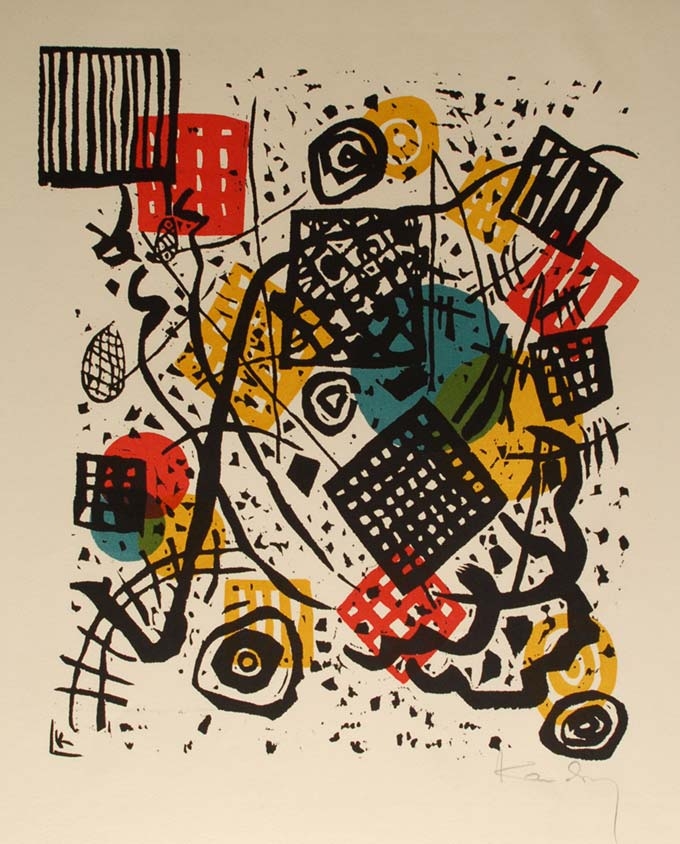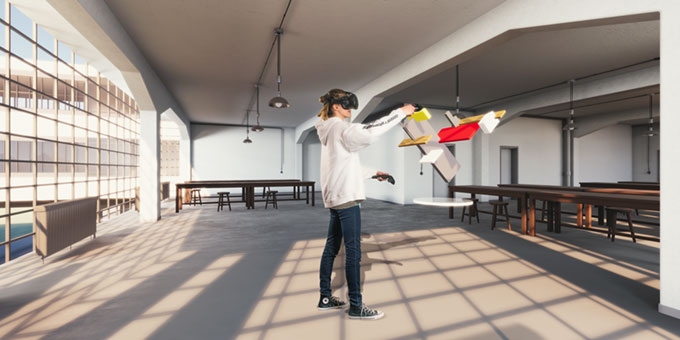Weimar, Dessau, Berlin: The Bauhaus as School and Laboratory
–
Established over a century ago in a society and economy reeling from the catastrophic human and economic impacts of World War One, the Bauhaus was an experimental school, a modern laboratory for artistic and social innovation. Over a period of 14 tumultuous years, from Weimar to Dessau and, finally, Berlin, its students and teachers endeavored to construct a new society by reimagining arts education and design work. Drawing inspiration from the Arts and Crafts Movement and pre-war design reform initiatives, the Bauhaus integrated fine-art and craft-based education in its famed workshops, recast professors as masters and students as apprentices, and attempted to build bridges between art and industry.

Wassily Kandinsky (Russian, 1866–1944), Kleine Welten V, 1922, colored woodcut, 14 3/16 x 11 inches. Courtesy of the Sabarsky Foundation.
Organized by workshop, this exhibit invites visitors to step into the shoes of a Bauhaus student (Bauhäusler) and begin their exploration with the preliminary course (Vorkurs), a foundational study of materials and artistic theory experienced by all students, before discovering the range of artistic media and educational philosophies taught across the school. The exhibition investigates how sociopolitical and ideological shifts impacted Bauhaus workshops, while highlighting continuities in teaching, design work, and student life from the founding of the school in 1919 until its closure under pressure from the National Socialists in 1933. Emphasizing the place of students and the role of life reform, play, and experimentation at one of the most influential art schools of the 20th century, the exhibition asks, “What does it mean to think and design like a Bauhäusler?”
At the center of the exhibition is the preliminary course (or Vorkurs), the introductory course in material study and design required of all students at the Bauhaus. While the structure and methods of the course varied by instructor, the overarching aims of the course remained central to a Bauhaus education: to prompt students to develop original designs by stripping away traditional notions of learning by copying, and replacing them with learning by doing, making mistakes, and experimental problem solving. This pedagogy is central to Bauhaus philosophy, and the exhibition itself.

Visitors to the exhibit will have the opportunity to experience a number of the Bauhaus Vorkurs exercises via virtual reality sessions led by the museum’s Sabarsky Graduate Fellow.
Weimar, Dessau, Berlin: The Bauhaus as School and Laboratory was curated by Erin Sassin, Assistant Professor of the History of Art and Architecture, and Sarah Briggs ’14, the museum’s 2019–2020 Sabarsky Graduate Fellow, with significant input from the students of the Fall 2019 course “Exhibiting the Bauhaus.” The exhibit was made possible by the generous support of the Christian A. Johnson Memorial Fund, Historic New England, the Goethe Institute, Bowdoin College, and the Sabarsky Collection, which made works from its large collection of German and Austrian art available to Middlebury students and faculty.
Students were deeply involved in the planning of this exhibition, from refining the curatorial narrative, researching the objects on view, and drafting wall texts to executing their own designs following prompts from the preliminary course. In the interest of making the visitor experience more playful and interactive, students also created supplementary exhibition materials, produced a soundscape, and reimagined Bauhaus products and color theory exercises.
